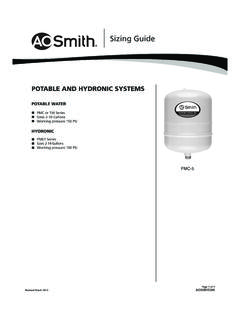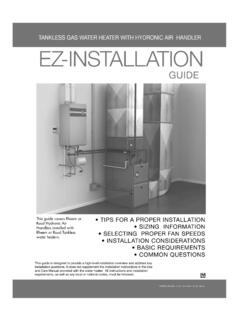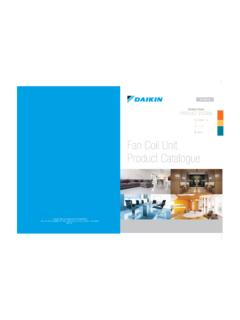Transcription of Geothermal Heat Pump Systems - Michigan
1 1 Curtis J. Klaassen, Energy CenterEnergy Resource StationGeothermalHeat Pump SystemsGeoExchange Technology Introduction What is Geothermal Energy? Geothermal Heat Pump system Types Geothermal system Features Pros and Cons Applications Economics and the Bottom LineQuestions at Any Heat Pump Technology2 Energy in Buildings Buildings Use 39% of the Nation s Primary Energy21%18%33%28%ResidentialCommercialI ndustryTransportationTotal Residential = 21%Total Commercial = 18%Energy Efficiency Building Blocks Step 1 Reduce Energy Load Site Orientation and Building Arrangement Efficient and Effective Building Envelope Step 2 Improve Efficiency of Systems and Equipment HVAC Systems Geothermal Systems Efficient A/C units, Boilers, Motors, Light Fixtures Lighting Systems Daylighting Computers and Office Equipment Step 3 Effective Building Operations Proper Control Energy Management Systems Commissioning Operations and Maintenance Training and Support Leverage Utility Company Rate Schedules Step 4 Alternative Energy Sources Renewable Energy Options Solar, Wind, Biomass3 What Is Geothermal Energy?
2 Geothermal Energy is defined as energy from the internal heat of the earth 47% of the incoming radiation from the sun is absorbed by the earth The remainder is absorbed by the atmosphere or reflected back into space Translated: Geo-Thermal means Earth-Heat High Temperature Geothermal Energy Energy Source for Hot springs and geysers Temperatures exceed 300 F Converted to produce useable heat and electricity Low Temperature Geothermal Energy Heat Energy contained near the surface of the Earth Shallow Earth temperatures fluctuate with seasonal outside air temperature Earth temperature becomes more stable with increasing depth Nearly constant Earth temperatures at depths below 16 feet Earth mean temperature approaches annual average outside air temperature Deep Earth temperatures start to increase at depths below 400 feet-- at about 1 F per 100 feet4 Low Temperature Geothermal Energy Geothermal Heat Pump Systems Take advantage of Low Temperature Geothermal Energy Constant Temperature Year Around 47 to 50 F in Michigan Apply a Water Source Heat Pump to amplify the heat energy AKA Ground Source Heat Pumps Earth Coupled Heat Pumps
3 GeoExchange Systems Well/Ground Water Heat Pumps High Temperature Geothermal Characterized by Medium used for Heat Source and Heat Sink Air to Air or Air Source Water to Air or Water Source Water to Water Ground Source or Geothermal Capable of Heating, Cooling and producing Hot Water Capacity measured in tons One tonof capacity = 12,000 BTU per hour (Cooling or Heating) Typical new home is about 4 5 tons of heating capacity & 2 tons cooling Typical Classroom is about 2 3 tons of heating or cooling capacityWhat are Heat Pumps?5 Geothermal Heat Pump system Heating/Cooling Delivery system Traditional Ductwork / Piping system to deliver heat throughout the building Heat Pump Mechanical Unit that moves heat from the working fluid, concentrates it, and transfers the heat to the circulating air Ground Heat Exchanger Underground piping system that uses a working fluid to absorb or reject heat from the groundThree Basic Components.
4 GeoExchange system Types Closed Loop system Buried HDPE Piping Underground Heat Exchanger Circulating Fluid contained Exchanges only Heatwith the Ground Various Configurations Open system Ground Water from Well Exchanges Heat and Waterwith the Ground Returns Water to the Ground Special Systems City Water Interconnect Systems Hybrid Systems6 Horizontal Trench Loop Cost effective when land area is plentiful Needs 2500 square foot Land area per ton Trench depth Six feet or moreGEOTHERMAL PIPE To Produce 1 ton of capacity: Trench length typically 300 feet Pipe length out & back = 600 feetCourtesy IGSHPAC ourtesy IGSHPAH orizontal Trench Configurations72 inch Headers3 CircuitsHorizontal LoopThree Circuits each with Four Trenches and 4 pipes in each trenchNominal 24 Ton Configuration12 Horizontal Trenches Each 300 foot long with Four inch pipesSlinky LoopSlinky Coil Overlap Slinky Coil Extended To Produce 1 ton of capacity.
5 Trench length typically 125 feet Pipe length out & back = 700 feetCourtesy IGSHPA8 Vertical Bore Loop Keeps Space required to a minimum Needs 250 Square Feet Land area per ton Bore Depth 100 to 300 feet Bore Diameter about 4 to 5 inches Bore Spacing 15 to 20 feet apart Nominal Capacity One ton / 200 ft Bore Hole Vertical Bore Grouting Grouting of Vertical Bore Holes Required Seal Borehole to Protect Underground Aquifers Maintain Thermal contact between pipe and ground Allow movement of pipe Grout Types Bentonite Based Thermally Enhanced Cement Based Pressure Grouting from the bottom up recommendedCourtesy ASHRAE GSHP Engineering Manual9 Vertical Loop2 inch Header PipesNominal 24 Ton Configuration200 foot Deep Vertical Bores with Pipes3 Circuits with 8 Bores each CircuitHorizontal Boring Horizontal / Directional Boring Machine used Horizontal length typically 200 feet for one ton of capacity Bore depth controlled at 15 feet Setup from one hub location for multiple radial bores Minimal disturbance to topsoil and landscaping10 Pond Loop Most Cost Effectiveclosed loop design Pond Depth 12 15 ft minimum maintained depth Pipe Length One 300 ft.
6 Coil per ton (minimum) Capacity 10 to 20 tons/acre of pond2 Tons3 Tons4 TonsPond Loop11 Pond Loop InstallationOpen Loop Very Cost Effective, providing the following are verified: Water Quality is High Water Quantity is Sufficient Meets Codes and Regulations AKA Pump and Dump to 2 GPM per ton required At 30% run time a 4 ton unit could use 100,000 gallons per month Typical Family of Four uses about 6,000 gallons per month for domestic purposes12 GeoExchange system Types Special Systems Standing Water Well Extraction and Rejection to the same well Concentric Pipe Return water on Outside Pipe Bleed off water for temperature control Interconnection to City Water Mains Extract heat from water mains with heat exchanger Return water to water mains downstream Hybrid Systems Coldest days -- use auxiliary heat source Hottest days -- supplement with cooling towerEnergyPros and ConsGeoExchange system Features13 GeoExchange system Features Energy Pros+GeoExchange Heating Contribution 1 kW electricity plus 3 kW Geothermal heat moved from the earth = 4 kW heat delivered Heating COP of to +GeoExchange Cooling Contribution Earth temperature sink cooler than air temperatures = reduced cooling compressor work Cooling EER of 14 to 27 (on 2 speed units)
7 +Individual units allow zoning for off hour use+Reduced site energy consumption: 30% - 50% less +Lower energy costs: 20% - 30% lessGeoExchange system Features Energy Cons Economizer Free Cooling not normally available Ventilation/make up air energy handled separately Energy Considerations=EER and COP include allowances for fan and pump energy=Distinction between EER and SEER=Minimize Circulating Pump energy =Water to Water Heating Options14 Energy Considerations Heat Pumps Ground Source Heating Efficiency measured by COP (Coefficient of Performance) Cooling Efficiency measured by EER (Energy Efficiency Ratio) Efficiency measured at Specific Temperatures and ConditionsWhat are the Actual Entering Water Temperatures? + LoopCOP @ 32 F EER @ 77 + + +High AvailableOpen LoopCOP @ 50 F EER @ 59 FEfficiency RatingARI / ASHRAE / ISO 13256 - 1 MTWTFSS70 FGeoExchange system EWT SummerEER = 20 EER = 1615-15-10-505101520253035404550 Sunday,January 25,2004 Monday,January 26,2004 Tuesday,January 27,2004 Wednesday,January 28,2004 Thursday,January 29,2004 Friday,January 30,2004 Saturday,January 31,2004 Temperature - Deg FGeoEx_LWSTGeoEx_LWRTOA_TempOutside Air TempSupply TempReturn Deg Deg FGeoExchange system EWT WinterIAMU GLSWT vs.
8 GLRWT (day average): 2001404550556065701/11/313/24/15/15/316/ 307/308/299/2810/2811/2712/27 Year 2001 DateTemperature (Deg F)GLSWTGLRWT 48 F64 FGeoExchange system EWT -- Annual16 Energy Considerations Circulating Pump Energy Pumping Energy Can Be Significant due to 24 / 7 Load Factor Minimizing Pump Head effective Many Geothermal Systems have excess Pumping Energy Circulating Pump Monitored Energy Use: Represents 8 % of the HVAC Metered Peak Demand Consumes 36 % of the Total Building HVAC Energy Responsible for 18 % of the Total Building Energy Costs Evaluate Pumping Options Decentralized Loop Distribution Two stage parallel pumping Variable Flow pumping w/VFD s Energy Considerations ASHRAE Technical Paper Energy Use of Pumping Options for Ground Source Heat Pumps An ASHRAE Technical Paper by Stephen Kavanaugh, PhD. and Sally McInerny, , SpeedPrimary /SecondaryVariable SpeedDecentralizedLoop PumpsAnnualPumpEnergykWhEvaluated Energy Consumption of 4 Pumping Systems Constant Speed Primary / Secondary Variable Speed Drive Decentralized PumpingMajority of Savings due to the ability to cycle off pumps during unoccupied hours and lower pump head requirements108,60065,50018,80013,10017 Energy Considerations Pump Energy Report CardBy Stephen Kavanaugh, PhDF Bad 15 or MoreD Poor10 to 15C to 10B Good5 to Excellent5 or LessGradePump Power per 100 tonsOperation and MaintenancePros and Cons18 Operation and Maintenance Pros+Unitary equipment failure of one unit+Simple, not complex Reduces Service Contracts+Avoids Boiler.
9 Condensing Units or Cooling Towers+Elaborate Control Systems not required+No annual Boiler Teardown and InspectionsGeoExchange system FeaturesGeoExchange system Features Maintenance and Operations Cons Quantity of units to maintain Air filters and drain pans (unitary) Heat pump locations accessible Maintenance Considerations=Refrigerant 22 vs 410A=Equipment/compressor service life of 19 years=Looping piping service life of 50 + years19 EnvironmentalPros and ConsGeoExchange system Features Environmental Pros+More comfortable indoor environment>Each unit operates independently, allowing either heating or cooling to occur as required>Individual Room Control of Heating or Cooling+No Make-Up Water for Boiler / Cooling Tower +No Chemical Treatment / Hazardous Materials+Eliminate Carbon Monoxide (CO) Potential+No Vandalism or Security Concerns+Minimal floor area required+Less energy means less natural resources and less pollution20 GeoExchange system Features Environmental Cons Noise inside building Environmental Considerations=Selection of Circulating Fluids=Temporary disturbance of landscaping=Design for proper indoor air qualityWhere does a GeoExchange SystemApply?
10 21 GeoExchange Applications New Construction Integrate GeoExchange into design Optimize system efficiency and costs Retrofit Construction Air condition existing non A/C building Replace Unit Ventilators or Fan Coil Units Minimum disturbance for Historical PreservationGeoExchange Applications Building Type Good application: Single-story finger plan Balanced envelope / interior thermal loads Weak application: New well insulated multi-story box with high internal loads Residential Excellent application22 GeoExchange Applications Schools are Good Candidatesfor GeoExchange Systems9 Retrofit older systems9 Air conditioning upgrade9 School building layout normally good for balanced heating/cooling loads9 Typical classroom good economic size for heat pump9 Open field area available for Geothermal Heat Exchanger9 system advantages attractive to schools9 Schools will be around to enjoy the life cycle cost benefitsGeoExchange Applications Domestic Water Heating Applications Desuperheater kit to heat domestic water Standard Option Cooling Season = Free water heating Heating Season = High COP water heating Water to water heat pumps preheat Domestic Water at a COP of Water to Water Heat Pump Applications Hydronic Systems Radiant floor Systems Heating water/chilled water source for Outside Air/ Ventilation Air with












